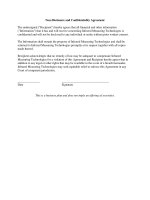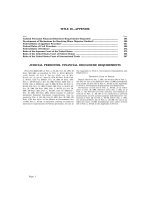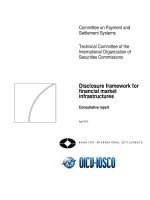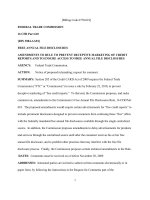IoTSF vulnerability disclosure
Bạn đang xem bản rút gọn của tài liệu. Xem và tải ngay bản đầy đủ của tài liệu tại đây (3.46 MB, 8 trang )
Vulnerability Disclosure
Release 1.0
Best Practice Guidelines
© 2016 IoT Security Foundation
Notices, Disclaimer, Terms of Use,
Copyright and Trade Marks and
Licensing
Notices
Documents published by the IoT Security
Foundation (“IoTSF”) are subject to regular review
and may be updated or subject to change at any
time. The current status of IoTSF publications,
including this document, can be seen on the
public website at: https://iotsecurityfoundation.
org/
The contents of this document are provided for
general information only and do not purport to
be comprehensive. No representation, warranty,
assurance or undertaking (whether express or
implied) is or will be made, and no responsibility
or liability to a recipient or user of this document
or to any third party is or will be accepted by IoTSF
or any of its members (or any of their respective
officers, employees or agents), in connection
with this document or any use of it, including in
relation to the adequacy, accuracy, completeness
or timeliness of this document or its contents.
Any such responsibility or liability is expressly
disclaimed.
Terms of Use
Nothing in this document excludes any liability for:
The role of IoTSF in providing this document is (i) death or personal injury caused by negligence;
to promote contemporary best practices in IoT or (ii) fraud or fraudulent misrepresentation.
security for the benefit of society. In providing By accepting or using this document, the recipient
this document, IoTSF does not certify, endorse or or user agrees to be bound by this disclaimer. This
affirm any third parties based upon using content disclaimer is governed by English law.
provided by those third parties and does not
verify any declarations made by users.
Copyright, Trade Marks and Licensing
In making this document available, no provision All product names are trade marks, registered
of service is constituted or rendered by IoTSF to trade marks, or service marks of their respective
any recipient or user of this document or to any owners.
third party.
Copyright © 2016, IoTSF. All rights reserved.
Disclaimer
IoT security (like any aspect of information
security) is not absolute and can never be
guaranteed. New vulnerabilities are constantly
being discovered, which means there is a need
to monitor, maintain and review both policy and
practice as they relate to specific use cases and
operating environments on a regular basis.
This work is licensed under the Creative Commons
Attribution-NoDerivatives 4.0 International
License. To view a copy of this license, visit
Creative Commons Attribution-NoDerivatives
4.0 International License.
Acknowledgements
We wish to acknowledge significant contributions
IoTSF is a non-profit organisation which
from IoTSF members and external reviewers.
publishes IoT security best practice guidance
materials. Materials published by IoTSF include
¥ Steve Babbage, Vodafone Group Plc
contributions from security practitioners,
¥ Craig Heath, Franklin Heath Ltd
researchers, industrially experienced staff and
¥ John Haine, University of Bristol
other relevant sources from IoTSF’s membership
¥ Richard Marshall, Xitex Ltd
and partners. IoTSF has a multi-stage process
¥ John Moor, IoT Security Foundation
designed to develop contemporary best practice
¥ Kenny Paterson, Royal Holloway of London
with a quality assurance peer review prior to
¥ David Rogers, Copper Horse Solutions Ltd
publication. While IoTSF provides information
in good faith and makes every effort to supply
correct, current and high quality guidance, IoTSF
provides all materials (including this document)
solely on an ‘as is’ basis without any express or
implied warranties, undertakings or guarantees.
Vulnerability Disclosure Guidelines
Release 1.0
-2-
© 2016 IoT Security Foundation
Contents
1
INTRODUCTION.............................................................................4
1.1 OVERVIEW.......................................................................................4
1.2 SCOPE..............................................................................................4
2
VULNERABILITY DISCLOSURE PROCESS GUIDELINES.....4
2.1 WEBSITE............................................................................................4
2.2 SAMPLE WEB PAGE TEXT............................................................4
2.3 MEANS OF CONTACT....................................................................5
2.4 COMMUNICATING WITH THE RESEARCHER.......................5
2.5 RESOLVING CONFLICT..................................................................5
2.6 TIMING OF RESPONSE..................................................................5
2.7 SECURITY ADVISORY.....................................................................6
2.8 CREDIT WHERE CREDIT IS DUE................................................6
2.9 MONEY...............................................................................................6
2.10 DISCOURAGING DAMAGING ACTIONS................................6
3
INTERNAL ORGANISATION AND PROCESSES.....................6
4
REFERENCES AND ABBREVIATIONS.......................................7
4.1 REFERENCES....................................................................................7
4.2 DEFINITIONS AND ABBREVIATIONS........................................7
.
Vulnerability Disclosure Guidelines
Release 1.0
-3-
© 2016 IoT Security Foundation
1
Introduction
particularly regarding individuals’ personal data,
in the territories and/or industry sectors in
which they operate. You should ensure that your
1.1 Overview
organisation is fully aware of, and in compliance
Vulnerability disclosure is an increasingly with, any data protection requirements which
important topic, especially for providers of may apply.
Internet-of-Things (IoT) products and solutions.
To avoid unnecessary risk to both the providers
Vulnerabilityn Disclosure
and users of these offerings when security issues 2
are found by external parties, providers should
Process Guidelines
set expectations of a clear process for responding
to reports of such issues and for managing the It is up to each individual provider to decide
public disclosure of information regarding them. exactly what process to adopt, but it is important
The process should cover both the reporting of to be clear about the process in public materials,
newly discovered security vulnerabilities to the websites and in communications with researchers
product- or service-providing organisation and the in order to align expectations. It can also be
public announcement of security vulnerabilities beneficial to have a certain amount of flexibility
by that organisation (usually following the in certain cases.
release of a software patch, hardware fix, or other
Alternative types of disclosure process will
remediation).
be discussed in our companion introductory
This
document
provides
manufacturers, material. For typical use, we are describing
integrators, distributors and retailers of IoT what is called there a “Coordinated Vulnerability
products and services with a set of guidelines for Disclosure” process, as being the most equitable
handling the disclosure of security vulnerabilities, and reasonable.
based on best practice and international standards.
The IoT Security Foundation are also developing 2.1 Website
a companion document to be released in early
2017, Introduction to Vulnerability Disclosure in the It is essential that security researchers can be
Internet of Things, which introduces the concepts channelled to the right point of contact within
and discusses the advantages of managing the provider organisation, so it is imperative that
there is an easy-to-find web page which contains
vulnerability disclosure in a standardised way.
all the necessary information. It is recommended
1.2 Scope
that the address: panydomain/
This document presents best practice guidelines security is used, so for the IoT Security Foundation
for a vulne-rability disclosure process, targeted for this is:
adoption by IoT solution providers, device vendors />and service providers. The recommended process It is also recommended that the organisation’s
is described by reference to the international ‘Contact’ page contains a referring link to the
standard ISO/IEC 29147:2014, Information Security page.
technology -- Security techniques -- Vulnerability
disclosure, [ISO2014] the electronic version of 2.2 Sample Web Page Text
which may be downloaded free of charge from The following is some proposed text for inclusion
the following URL:
on a Vulnerability Disclosure page on a company
/>website, to be approved by the company’s legal
PubliclyAvailableStandards/c045170_ISO_
team. Some companies also choose to specify
IEC_29147_2014.zip
what they consider to be unacceptable security
research (such as that which would lead to the
Please note that this document does not address
disclosure of customer data):
the management of any data breach which may
have resulted from the exploitation of a security
“[Company Name] takes security issues extremely
vulnerability; an organisation’s responsibilities
seriously and welcomes feedback from security
regarding this are usually determined by applicable
researchers in order to improve the security of its
legislation and government regulations,
Vulnerability Disclosure Guidelines
Release 1.0
-4-
© 2016 IoT Security Foundation
products and services. We operate a policy of made into researching the particular security
coordinated disclosure for dealing with reports of problem. Their motivation and expectations
security vulnerabilities and issues.
may well differ from yours, so it is imperative
that they are given enough room to work with
To privately report a suspected security you and that a constructive, understanding tone
issue to us, please send an email to security is adopted at all times even if their actions may
alert@<companydomain>, giving as much detail seem inappropriate in your business context.
as you can. We will respond to you as soon
as possible. If the suspected security issue is 2.5 Resolving Conflict
confirmed, we will then come back to you with
an estimate of how long the issue will take to fix. It is likely that at some point, there are going
Once the fix is available, we will notify you and to be issues where both parties disagree. The
Organisation for Internet Safety guidelines [OIS]
recognise your efforts on this page.
included recommendations on how to resolve
such conflicts in the context of an organisation’s
Thank You
published vulnerability disclosure process. In
Thanks to the following people who have helped summary:
make our products and services more secure by
¥ Leave the process only after exhausting
making a coordinated disclosure with us:
reasonable
efforts to resolve the disagreement;
[Name/alias, Twitter handle]”
¥ Leave the process only after providing
2.3 Means of Contact
notice to the other party;
¥ Resume the process once the disagreement
The
address
security
is resolved.
alert@<companydomain>
or
security@<companydomain> is a de facto standard 2.6 Timing of Response
for researchers who disclose vulnerabilities to
organisations. We recommend that organisations The text on your security contact web page should
create and monitor both of these email addresses state in what time frame the security researcher
can expect a response; this will typically be a few
where possible.
days, perhaps up to a week. It is good practice
It is important to provide a secure mechanism for to send an automatic acknowledgement for email
communication about security issues, to avoid sent to the contact email address including the
any risk of the communication being intercepted same details on the expected response time. The
and the information being used maliciously.
following response should then further clarify
expectations regarding the timing of further
It is recommended that organisations provide a communications and, once a problem has been
secured web form for the initial contact message, confirmed, in what time frame a patch, fix or other
as this does not require the reporting party remediation is expected to be made available.
to install email encryption software and the
necessary encryption keys, which can be prone It can be very difficult to estimate a reasonable
to error. Nevertheless, organisations should amount of time for a security vulnerability to be
consider also publishing a public key with which fixed. It depends on many factors, including the
emails can be encrypted for confidentiality.
nature of the affected component (e.g. a web
service, a software product or a hardware product),
2.4 Communicating with the Researcher
the technical complexity and architectural depth
Security researchers may have a wide variety of of the problem, and the mechanisms available
backgrounds and expectations; they may be, for for updating the offering. It is a topic that has
example, hobbyists unused to business processes, been debated at length amongst the security
academics who desire the freedom to publish community and continues to be a source of
research, or professional consultants building tension.
a reputation for expertise in finding security
problems. It is important, in communication It is important to communicate with the researcher
with researchers, that due consideration and and explain how you justify your estimated timing.
If the researcher feels that you are not
recognition is given to the effort that they have
Vulnerability Disclosure Guidelines
Release 1.0
-5-
© 2016 IoT Security Foundation
taking their report seriously enough, it may cause
a breakdown of the process and premature public
disclosure of the vulnerability. At one extreme,
for a simple problem in a live web service
involving individuals’ personal data, a reasonable
time to fix might be only a few days, but at the
other extreme, fixing a complex problem with a
physical product that requires new hardware to
be manufactured and distributed to repair centres
could take many months.
the trap of “shooting the messenger” when it
comes to the disclosure of a vulnerability. This is
why some people are suspicious of approaching
a company when they discover a security issue.
A company should, however, not encourage
damaging activity. Some security pages explicitly
exclude certain types of research – for example
Denial of Service attacks on a site or the hacking
into systems in order to expose customer data. An
example of this can be found in the IoT Security
2.7 Security Advisory
Foundation’s own vulnerability disclosure policy:
The organisation should have a mechanism via />which security advisories can be issued, so that
users can be informed once a problem is fixed. 3
Internal Organisation and Processes
This should be done via a secure webpage to
authenticate the information. Some organisations Successful vulnerability disclosure management
also use security announcement mailing lists; it is must involve a nominated responsible person. It
good practice to digitally sign the advisory email is suggested that this should be the CISO, or a
text so that it can be authenticated.
Head of Security Response if one is appointed.
In addition to this, it is recommended that
2.8 Credit Where Credit Is Due
confirmed disclosure emails sent to the disclosure
It is standard practice as a gesture of goodwill email address are distributed to a list of senior
and recognition of security researchers’ efforts to staff that should be aware of disclosures that are
name security researchers who have cooperated in underway. The remaining steps should continue
a vulnerability disclosure, although it is important as per the standard internal security incident
to confirm their consent to this before publicly handling processes of the organisation, with
identifying them. The acknowledgement is often the added aspects of communicating with the
done on the same web page as the vulnerability security researcher on a regular basis to update
disclosure policy. It is generally expected that a and possibly asking for additional information or
researcher’s Twitter handle (if available) will also assistance. The final step is the creation of the
security advisory and agreeing the “go public”
be included.
date with the researcher.
2.9 Money
There is a companion specification to ISO
Crediting a security researcher does not 29147, that is ISO/IEC 30111:2013, Information
necessarily indicate that they are financially technology -- Security techniques -- Vulnerability
compensated and such compensation is not handling processes [ISO2013], which goes into
generally expected. Companies may wish to more detail on internal processes for handling
Regardless of whether ISO
introduce “bug bounty” programmes or work with vulnerabilities.
30111
is
used
or
not,
the process to be followed
intermediaries who manage such programmes on
behalf of companies, but this topic is out of the should be appropriately documented within the
organisation.
scope of these recommendations.
2.10 Discouraging Damaging Actions
It can be argued that, by publishing a Vulnerability
Disclosure policy, organisations could be
encouraging hackers in the name of security
research. This is a misleading argument as, without
a published policy, the organisation is turning a
blind eye to research that would otherwise go on
without its knowledge. Companies can fall into
Vulnerability Disclosure Guidelines
Release 1.0
-6-
© 2016 IoT Security Foundation
4
References and Abbreviations
4.1 References
[ISO2013]
ISO/IEC 30111:2013, Information technology -- Security
techniques -- Vulnerability handling processes
[ISO2014]
ISO/IEC 29147:2014, Information technology -- Security
techniques -- Vulnerability disclosure
[OIS]
Organization for Internet Safety, Guidelines for Security
Vulnerability Reporting and Response, Version 2.0, 01
Sep 2004
4.2 Definitions and Abbreviations
Advisory
Breach
CISO
IoT
IoTSF
ISO
Researcher
Vulnerability
WG-4
An announcement or bulletin that informs users about a vulnerability in a
product or service, usually including instructions on how to remediate the
vulnerability
Any incident that results in unauthorized access to data, networks, devices or
services
Chief Information Security Officer
Internet of Things
Internet of Things Security Foundation
International Organization for Standardization
An external discoverer of a security vulnerability (referred to in ISO 29147 as
“finder”)
A weakness in a system that can be exploited to compromise security
IoTSF Working Group 4, Framework for Vulnerability Disclosure
Vulnerability Disclosure Guidelines
Release 1.0
-7-
© 2016 IoT Security Foundation
www.iotsecurityfoundation.org









